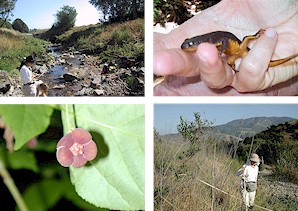Unit Inventory, Monitoring and Assessment
The key to a successful park inventory and monitoring program is developing clear goals and priorities. The Unit IMAP Planning Process describes 15 steps for developing and implementing an Inventory, Monitoring, and Assessment Program plan for a park that determines what should be inventoried and monitored. The Unit IMAP Planning Process is linked below:
Unit IMAP Planning Process
Methods

Terrestrial Amphibian and Reptile Protocol Table
Bird Protocol Table
Common Plants Protocol Table
Invasive Alien Plant Protocol Table
Sensitive Plants Protocol Table
Plant Community Protocol Table
Vegetation Fire Protocol Table
Fish Stream Protocol Table
Fish Lake-Estuary Protocol Table
Fish References Protocol Table
Bats Protocol Table
Rodent-Shrew Protocol Table
Medium-sized Territorial Carnivore Protocol Table
Sampling Design
After selecting a method to inventory and monitor a particular resource a study design must be prepared to specifically explain how the method will be applied to meet the project’s objectives. The study design should be prepared as a draft and revised, as needed, after conducting a pilot study in the field that will most likely show the need for modifications based on local conditions.
The following are examples of study designs prepared for selected IMAP projects. Additional study designs will be added to this section as they become available. To get information about individual study designs please click on the study type below:
Stream Macroinvertebrates Study Design
Stream Water Quality Study Design
Groundwater Study Design
Pig Damage Study Design
Pilot Projects

Unit IMAP plans were prepared for both Chino Hills SP and Wilder Ranch SP. The IMAP plans identified and prioritized which resources would be inventoried and monitored. Preliminary field efforts at both pilot projects began in summer 2000. Study designs were developed during winter 2000/2001 and collection of field data began in spring 2001 and was completed in 2002. The projects are described further in the following links.
Chino Hills SP - IMAP Pilot Project
Wilder Ranch SP - IMAP Pilot Project
